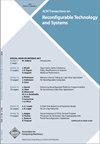一种提高基于可扩展CORDIC的深度神经网络性能的经验方法
IF 2.8
4区 计算机科学
Q2 COMPUTER SCIENCE, HARDWARE & ARCHITECTURE
引用次数: 0
摘要
深度神经网络(DNN)的实际实现需要大量的硬件资源,需要高计算能力和内存带宽。虽然现有的基于现场可编程门阵列(FPGA)的DNN加速器主要针对快速单任务性能进行了优化,但成本、能效和整体吞吐量是其在各种应用中实际使用的关键考虑因素。本文提出了一种以性能为中心的流水线式坐标旋转数字计算机(CORDIC)MAC单元,并实现了一种可扩展的基于CORDIC的DNN架构,该架构具有面积和功率效率,并具有高吞吐量。基于CORDIC的神经元引擎使用位舍入来保持输入输出精度和最小的硬件资源开销。结果证明了所提出的流水线MAC的多功能性,它在460MHz下工作,并允许更高的网络吞吐量。基于软件的实现平台针对更广泛的神经网络和复杂的数据集评估所提出的MAC操作的准确性。设计了具有参数化和模块化层复用结构的DNN加速器。通过Pareto分析的经验评估通过固定算法精度和最佳流水线阶段来提高DNN实现的效率。所提出的体系结构利用了层复用,这是一种有效地重用单个DNN层以提高效率的技术,同时保持了集成各种网络配置的模块性和适应性。所提出的基于CORDIC MAC的DNN架构可扩展到任何比特精度的网络大小,并且DNN加速器是使用Xilinx Virtex-7 VC707 FPGA板原型化的,工作频率为66 MHz。所提出的设计不使用任何Xilinx宏,使其易于适用于ASIC实现。与最先进的设计相比,所提出的设计在不牺牲性能的情况下减少了45%的资源使用和4倍的功耗。该加速器使用MNIST数据集进行了验证,准确率达到95.06%,仅比其他尖端实现低0.35%。本文章由计算机程序翻译,如有差异,请以英文原文为准。
An Empirical Approach to Enhance Performance for Scalable CORDIC-Based Deep Neural Networks
Practical implementation of deep neural networks (DNNs) demands significant hardware resources, necessitating high computational power and memory bandwidth. While existing field-programmable gate array (FPGA)–based DNN accelerators are primarily optimized for fast single-task performance, cost, energy efficiency, and overall throughput are crucial considerations for their practical use in various applications. This article proposes a performance-centric pipeline Coordinate Rotation Digital Computer (CORDIC)–based MAC unit and implements a scalable CORDIC-based DNN architecture that is area- and power-efficient and has high throughput. The CORDIC-based neuron engine uses bit-rounding to maintain input-output precision and minimal hardware resource overhead. The results demonstrate the versatility of the proposed pipelined MAC, which operates at 460 MHz and allows for higher network throughput. A software-based implementation platform evaluates the proposed MAC operation’s accuracy for more extensive neural networks and complex datasets. The DNN accelerator with parameterized and modular layer-multiplexed architecture is designed. Empirical evaluation through Pareto analysis is used to improve the efficiency of DNN implementations by fixing the arithmetic precision and optimal pipeline stages. The proposed architecture utilizes layer-multiplexing, a technique that effectively reuses a single DNN layer to enhance efficiency while maintaining modularity and adaptability for integrating various network configurations. The proposed CORDIC MAC-based DNN architecture is scalable for any bit-precision network size, and the DNN accelerator is prototyped using the Xilinx Virtex-7 VC707 FPGA board, operating at 66 MHz. The proposed design does not use any Xilinx macros, making it easily adaptable for ASIC implementation. Compared with state-of-the-art designs, the proposed design reduces resource use by 45% and power consumption by 4× without sacrificing performance. The accelerator is validated using the MNIST dataset, achieving 95.06% accuracy, only 0.35% less than other cutting-edge implementations.
求助全文
通过发布文献求助,成功后即可免费获取论文全文。
去求助
来源期刊

ACM Transactions on Reconfigurable Technology and Systems
COMPUTER SCIENCE, HARDWARE & ARCHITECTURE-
CiteScore
4.90
自引率
8.70%
发文量
79
审稿时长
>12 weeks
期刊介绍:
TRETS is the top journal focusing on research in, on, and with reconfigurable systems and on their underlying technology. The scope, rationale, and coverage by other journals are often limited to particular aspects of reconfigurable technology or reconfigurable systems. TRETS is a journal that covers reconfigurability in its own right.
Topics that would be appropriate for TRETS would include all levels of reconfigurable system abstractions and all aspects of reconfigurable technology including platforms, programming environments and application successes that support these systems for computing or other applications.
-The board and systems architectures of a reconfigurable platform.
-Programming environments of reconfigurable systems, especially those designed for use with reconfigurable systems that will lead to increased programmer productivity.
-Languages and compilers for reconfigurable systems.
-Logic synthesis and related tools, as they relate to reconfigurable systems.
-Applications on which success can be demonstrated.
The underlying technology from which reconfigurable systems are developed. (Currently this technology is that of FPGAs, but research on the nature and use of follow-on technologies is appropriate for TRETS.)
In considering whether a paper is suitable for TRETS, the foremost question should be whether reconfigurability has been essential to success. Topics such as architecture, programming languages, compilers, and environments, logic synthesis, and high performance applications are all suitable if the context is appropriate. For example, an architecture for an embedded application that happens to use FPGAs is not necessarily suitable for TRETS, but an architecture using FPGAs for which the reconfigurability of the FPGAs is an inherent part of the specifications (perhaps due to a need for re-use on multiple applications) would be appropriate for TRETS.
 求助内容:
求助内容: 应助结果提醒方式:
应助结果提醒方式:


